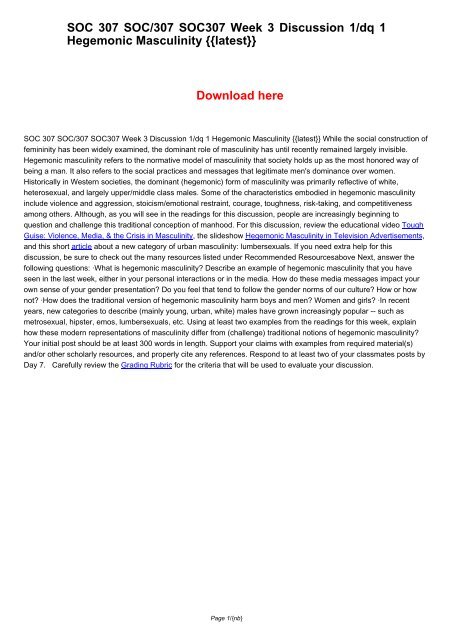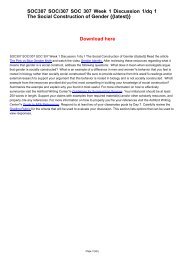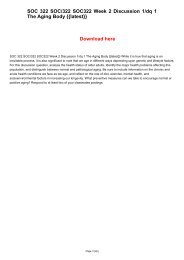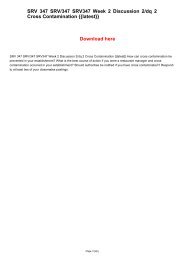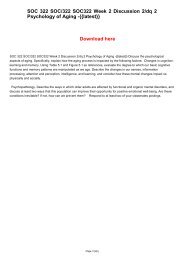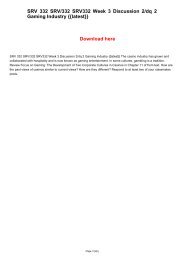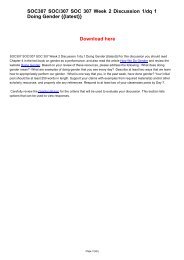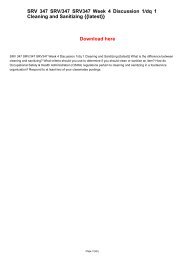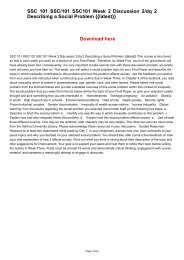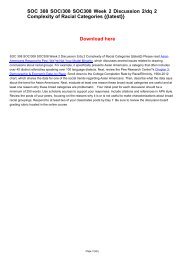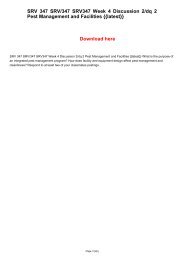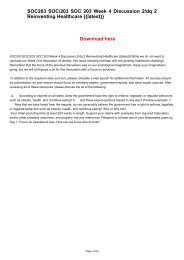SOC 307 SOC/307 SOC307 Week 3 Discussion 1/dq 1 Hegemonic Masculinity {{latest}}
SOC 307 SOC/307 SOC307 Week 3 Discussion 1/dq 1 Hegemonic Masculinity {{latest}}
SOC 307 SOC/307 SOC307 Week 3 Discussion 1/dq 1 Hegemonic Masculinity {{latest}}
Create successful ePaper yourself
Turn your PDF publications into a flip-book with our unique Google optimized e-Paper software.
<strong>SOC</strong> <strong>307</strong> <strong>SOC</strong>/<strong>307</strong> <strong>SOC</strong><strong>307</strong> <strong>Week</strong> 3 <strong>Discussion</strong> 1/<strong>dq</strong> 1<br />
<strong>Hegemonic</strong> <strong>Masculinity</strong> {{<strong>latest</strong>}}<br />
Download here<br />
<strong>SOC</strong> <strong>307</strong> <strong>SOC</strong>/<strong>307</strong> <strong>SOC</strong><strong>307</strong> <strong>Week</strong> 3 <strong>Discussion</strong> 1/<strong>dq</strong> 1 <strong>Hegemonic</strong> <strong>Masculinity</strong> {{<strong>latest</strong>}} While the social construction of<br />
femininity has been widely examined, the dominant role of masculinity has until recently remained largely invisible.<br />
<strong>Hegemonic</strong> masculinity refers to the normative model of masculinity that society holds up as the most honored way of<br />
being a man. It also refers to the social practices and messages that legitimate men's dominance over women.<br />
Historically in Western societies, the dominant (hegemonic) form of masculinity was primarily reflective of white,<br />
heterosexual, and largely upper/middle class males. Some of the characteristics embodied in hegemonic masculinity<br />
include violence and aggression, stoicism/emotional restraint, courage, toughness, risk-taking, and competitiveness<br />
among others. Although, as you will see in the readings for this discussion, people are increasingly beginning to<br />
question and challenge this traditional conception of manhood. For this discussion, review the educational video Tough<br />
Guise: Violence, Media, & the Crisis in <strong>Masculinity</strong>, the slideshow <strong>Hegemonic</strong> <strong>Masculinity</strong> in Television Advertisements,<br />
and this short article about a new category of urban masculinity: lumbersexuals. If you need extra help for this<br />
discussion, be sure to check out the many resources listed under Recommended Resourcesabove Next, answer the<br />
following questions: ·What is hegemonic masculinity? Describe an example of hegemonic masculinity that you have<br />
seen in the last week, either in your personal interactions or in the media. How do these media messages impact your<br />
own sense of your gender presentation? Do you feel that tend to follow the gender norms of our culture? How or how<br />
not? ·How does the traditional version of hegemonic masculinity harm boys and men? Women and girls? ·In recent<br />
years, new categories to describe (mainly young, urban, white) males have grown increasingly popular -- such as<br />
metrosexual, hipster, emos, lumbersexuals, etc. Using at least two examples from the readings for this week, explain<br />
how these modern representations of masculinity differ from (challenge) traditional notions of hegemonic masculinity?<br />
Your initial post should be at least 300 words in length. Support your claims with examples from required material(s)<br />
and/or other scholarly resources, and properly cite any references. Respond to at least two of your classmates posts by<br />
Day 7. Carefully review the Grading Rubric for the criteria that will be used to evaluate your discussion.<br />
Page 1/{nb}


